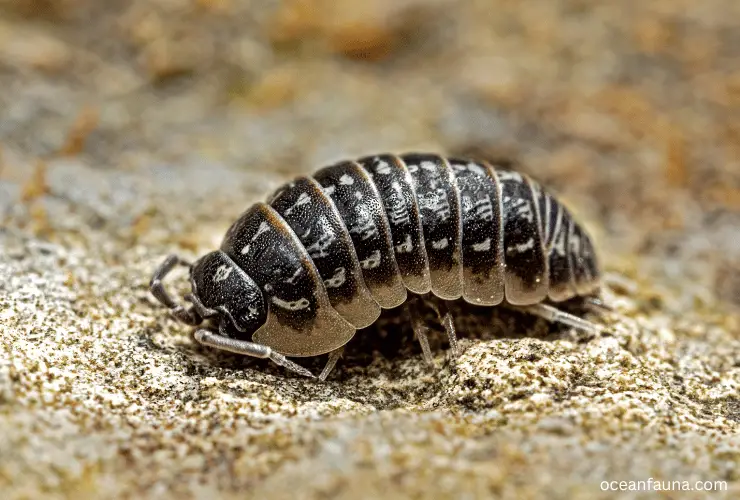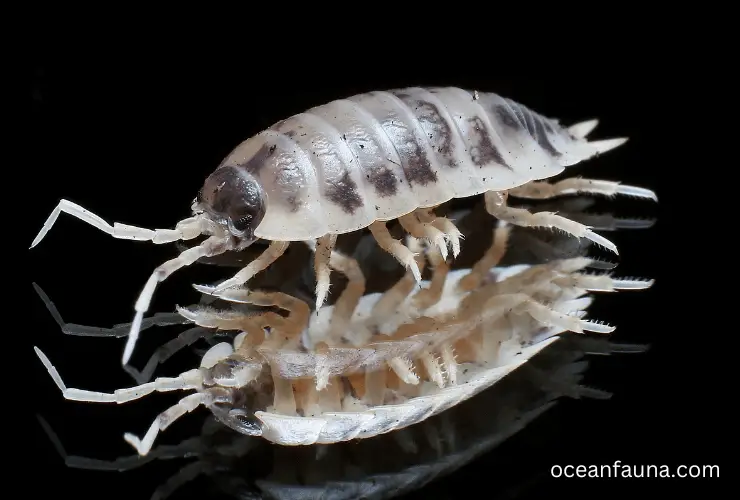Isopods are found everywhere, and they live by eating anything. Although most animals have a suitable habitat to live in and cannot survive in all types of environments, the question is, how is the isopod different? Well, it’s due to their unique body structure and respiration system.
How Do Isopods Breathe? What’s so unique about their respiration process?
Isopods breathe through a combination of cutaneous respiration and branchial respiration. The mode of respiration depends on the environment they are living in. Terrestrial isopods use cutaneous respiration by extracting oxygen through the exoskeleton. On the other hand, aquatic isopods use branchial respiration by extracting oxygen through specialized respiratory organs such as gills or book lungs. The circulatory and nervous system also plays a crucial role in the overall functioning of the respiratory system.
The ability of isopods to extract oxygen from the environment is crucial for their survival and behavior.
So, in this article, we will explore the different methods of respiration and breathing in isopods. We’ll also know how their unique respiration process allows these creatures to survive in a wide range of environments. Don’t skip and read to the end to explore some amazing facts about the breathing mechanism in isopods.
Types of Respiration in Isopods
As you already know, in humans and most animals, only one type of respiration is seen. But to your surprise, in isopods, two kinds of breathing are present.
Isopods use two main types of respiration: cutaneous and branchial.
Cutaneous respiration involves the diffusion of oxygen through the exoskeleton and body surface. On the other hand, branchial respiration involves the use of specialized gills or other respiratory organs.
How Do Isopods Breathe
Isopods, also known as sow bugs or pill bugs, have a unique respiratory system that allows them to survive in various conditions. They use two main methods of respiration: cutaneous and branchial.
The breathing process of isopods mainly occurs through the exchange of gases. And for the exchange of gases, isopods use gills. Isopods have a circulatory system that helps transport oxygen throughout the body. The heart pumps oxygen-rich blood to the body’s cells. It’s used for metabolism.

Unlike others, the gills of the tiny little creatures are present on their lower body (near the ground). They lie on top of the six to seven pairs of their legs. Due to this, the gills of isopods remain wet and hydrated most of the time.
To breathe properly, isopods use their six sets of gills. All the gills remain connected to pleopodal lungs. And the lungs are located behind their set of legs.
Additionally, the nervous system controls the respiratory process by regulating the rate and depth of breathing. This helps isopods adapt to different environments where oxygen availability may vary.
How Do Terrestrial Isopods Breathe?
Terrestrial isopods breathe through a process called cutaneous respiration. This process involves the diffusion of oxygen through the exoskeleton and body surface. This process allows the isopod to extract oxygen directly from the air.
The exoskeleton of terrestrial isopods is covered with a thin layer of moisture. This thin layer facilitates oxygen diffusion through the cuticle.
Terrestrial isopods also have a tracheal system that allows them to breathe through small openings on the sides of their bodies called spiracles. This system comprises a network of tubes that transport oxygen from the spiracles to the body’s cells.
The tracheal system allows the isopod to extract oxygen from the air and transport it to the body’s cells, which are used for metabolism.
Last but not least, the exoskeleton of terrestrial isopods’ helps prevent water loss and evaporation.
How Do Aquatic Isopods Breathe?
Aquatic isopods breathe through a process called branchial respiration. This process involves using specialized respiratory organs, such as gills, to extract oxygen from water.
The gills are highly vascularized structures equipped with fine filaments. The particular structures help to increase the surface area for gas exchange. These filaments are richly supplied with blood vessels, facilitating the diffusion of oxygen from the water into the isopod’s bloodstream.
Aquatic isopods have a specialized circulatory system that helps to transport oxygen from the gills to the rest of the body. This process allows the aquatic isopods to extract oxygen from water and survive in aquatic environments.
The Anatomy of Isopod Respiratory Systems
The respiratory system of isopods varies depending on the species and their environment.
You already know that have a tracheal system, which allows them to breathe through small openings on the sides of their bodies. And, Aquatic isopods, on the other hand, have gills or other specialized organs that allow them to extract oxygen from water. This respiration system is extremely vital for their adaptation to the wild.
The respiratory system of isopods plays a critical role in their survival and behavior, as it allows them to extract oxygen from the environment and transport it to the body’s cells. The anatomy of the respiratory system of isopods varies depending on the species and their environment.
Isopods also have a unique adaptation called ‘book lungs’ that allows them to extract oxygen from the air. Book lungs are flat, folded structures that are lined with fine filaments. Book lungs help increase the surface area for gas exchange. Oxygen diffuses through the walls of the book lungs into the blood vessels, where it is transported throughout the body.
This adaptation is present in some aquatic species of isopods, which allows them to extract oxygen from the air and survive in environments where the oxygen levels in the water may be low.
How Do Isopods Adapt to Different Environmental Conditions?
Isopods can survive in a wide range of environments, from damp forests to dry deserts, by adapting their respiratory system.
For example, terrestrial isopods have a hard exoskeleton that helps to prevent water loss. In contrast, aquatic isopods have gills or other specialized organs to extract oxygen from water.
Additionally, isopods can use cutaneous and branchial respiration to obtain oxygen, allowing them to survive in environments where one method may be less effective.
The Role of Respiration in Isopod Behavior and Survival
Respiration plays a critical role in the survival and behavior of isopods. This is one of the reasons behind the isopod excelling in odd environments.
Respiration is also closely tied to the behavior and survival of isopods. For example, the ability to extract oxygen through the exoskeleton or specialized organs allows isopods to survive in environments where oxygen is scarce. This adaptability enables isopods to survive in a wide range of environments, from damp forests to dry deserts and from freshwater to marine environments.

Additionally, the ability to switch between different respiration methods allows isopods to adapt to changing conditions and survive in a wide range of habitats.
Furthermore, the ability of isopods to extract oxygen from the environment also plays a role in the regulation of the water balance and osmoregulation of their body.
In conclusion, the respiratory system of isopods is a key aspect of their survival and behavior. The ability of isopods to use both cutaneous and branchial respiration, and their adaptability to different environments, allows them to survive in a wide range of environments and habitats.
Why Do Isopods Dehydrate Quickly?
Isopods must keep their bodies wet and moisturized to survive in odd environments. So while continuing this process, they often dehydrate their body, and it’s risky as it can even lead to death.
Isopods need to breathe effectively to prevent hypoxia or oxygen deficiency that may result from the isopod being buried under the soil.
Having more than one set of lungs allows the isopod to breathe effectively, despite being buried in an oxygen-deprived environment.
Isopods, such as the Armadillidium Vulgare or pillbug, have a unique way of staying hydrated in dry and hot environments. They curl up into a ball to protect their underside, gills, and pleopodal lungs from dehydration.
This is the typical behavior observed during the day, and it’s also why collecting these creatures should be avoided, as it could interfere with their natural process of breathing and staying hydrated.
FAQ
· Can terrestrial isopods breathe underwater?
Ans: Although isopods are found to be living anywhere in the wild, they prefer damp areas. The reason is they need to keep their gills moist. However, if the terrestrial ones are kept submerged in water for too long, they’ll die.
· Can isopods survive without oxygen?
Ans: Even though isopods are tiny in size, they need a lot of oxygen as they remain busy to ensure their survival in the wild. To survive a longer period, isopods need ventilation and moisture. And due to a deficiency of oxygen or air, they’ll suffocate.
Conclusion
Isopods are fascinating creatures that have adapted to survive in various environments.
In conclusion, the respiratory system of isopods is a unique and versatile system that allows these creatures to survive in a wide range of environments. From the tracheal system of terrestrial isopods to the gills and book lungs of aquatic isopods, each adaptation plays a critical role in the survival and behavior of these fascinating creatures.
Additionally, the circulatory and nervous systems play a crucial role in the overall functioning of the respiratory system. Understanding how it works can help us better understand these creatures and the ecosystems in which they live.
So how do isopods breathe? Well, I guess you’ve got your answer. We can understand it was a long read. Thank you for reading patiently to the end. And we believe we can help you explore the unique breathing system of isopods!


2 thoughts on “How Do Isopods Breathe? [Unique Respiratory System]”